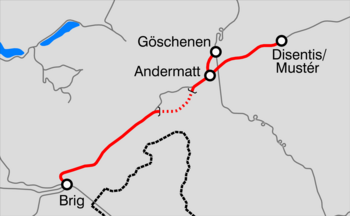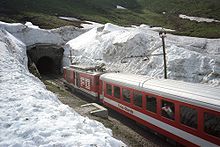Furka-Oberalp Railway
| Brig – Disentis / Mustér | |||||||||||||||||||||||||||||||||||||||||||||||||||||||||||||||||||||||||||||||||||||||||||||||||||||||||||||||||||||||||||||||||||||||||||||||||||||||||||||||||||||||||||||||||||||||||||||||||||||||||||||||||||||||||||||||||||||||||||||||||||||||||||||||||||||
|---|---|---|---|---|---|---|---|---|---|---|---|---|---|---|---|---|---|---|---|---|---|---|---|---|---|---|---|---|---|---|---|---|---|---|---|---|---|---|---|---|---|---|---|---|---|---|---|---|---|---|---|---|---|---|---|---|---|---|---|---|---|---|---|---|---|---|---|---|---|---|---|---|---|---|---|---|---|---|---|---|---|---|---|---|---|---|---|---|---|---|---|---|---|---|---|---|---|---|---|---|---|---|---|---|---|---|---|---|---|---|---|---|---|---|---|---|---|---|---|---|---|---|---|---|---|---|---|---|---|---|---|---|---|---|---|---|---|---|---|---|---|---|---|---|---|---|---|---|---|---|---|---|---|---|---|---|---|---|---|---|---|---|---|---|---|---|---|---|---|---|---|---|---|---|---|---|---|---|---|---|---|---|---|---|---|---|---|---|---|---|---|---|---|---|---|---|---|---|---|---|---|---|---|---|---|---|---|---|---|---|---|---|---|---|---|---|---|---|---|---|---|---|---|---|---|---|---|---|---|---|---|---|---|---|---|---|---|---|---|---|---|---|---|---|---|---|---|---|---|---|---|---|---|---|---|---|---|---|---|---|---|
| Timetable field : | 142, 144, 920 | ||||||||||||||||||||||||||||||||||||||||||||||||||||||||||||||||||||||||||||||||||||||||||||||||||||||||||||||||||||||||||||||||||||||||||||||||||||||||||||||||||||||||||||||||||||||||||||||||||||||||||||||||||||||||||||||||||||||||||||||||||||||||||||||||||||
| Route length: | 100.65 km | ||||||||||||||||||||||||||||||||||||||||||||||||||||||||||||||||||||||||||||||||||||||||||||||||||||||||||||||||||||||||||||||||||||||||||||||||||||||||||||||||||||||||||||||||||||||||||||||||||||||||||||||||||||||||||||||||||||||||||||||||||||||||||||||||||||
| Gauge : | 1000 mm ( meter gauge ) | ||||||||||||||||||||||||||||||||||||||||||||||||||||||||||||||||||||||||||||||||||||||||||||||||||||||||||||||||||||||||||||||||||||||||||||||||||||||||||||||||||||||||||||||||||||||||||||||||||||||||||||||||||||||||||||||||||||||||||||||||||||||||||||||||||||
| Power system : | 11 kV 16.7 Hz ~ | ||||||||||||||||||||||||||||||||||||||||||||||||||||||||||||||||||||||||||||||||||||||||||||||||||||||||||||||||||||||||||||||||||||||||||||||||||||||||||||||||||||||||||||||||||||||||||||||||||||||||||||||||||||||||||||||||||||||||||||||||||||||||||||||||||||
| Maximum slope : |
Adhesion 40 ‰ rack 110/179 ‰ |
||||||||||||||||||||||||||||||||||||||||||||||||||||||||||||||||||||||||||||||||||||||||||||||||||||||||||||||||||||||||||||||||||||||||||||||||||||||||||||||||||||||||||||||||||||||||||||||||||||||||||||||||||||||||||||||||||||||||||||||||||||||||||||||||||||
| Rack system : | Dept | ||||||||||||||||||||||||||||||||||||||||||||||||||||||||||||||||||||||||||||||||||||||||||||||||||||||||||||||||||||||||||||||||||||||||||||||||||||||||||||||||||||||||||||||||||||||||||||||||||||||||||||||||||||||||||||||||||||||||||||||||||||||||||||||||||||
|
|||||||||||||||||||||||||||||||||||||||||||||||||||||||||||||||||||||||||||||||||||||||||||||||||||||||||||||||||||||||||||||||||||||||||||||||||||||||||||||||||||||||||||||||||||||||||||||||||||||||||||||||||||||||||||||||||||||||||||||||||||||||||||||||||||||
The Furka-Oberalp-Bahn (FO) was a narrow-gauge railway company in Switzerland . It merged with BVZ Zermatt-Bahn on January 1, 2003 to form the Matterhorn-Gotthard-Bahn (MGB), which now operates the meter-gauge FO routes. The 97-kilometer main route connects the cantons of Graubünden , Uri and Valais . Originally it overcame the Furka Pass and the Oberalp Pass , but could only operate in summer. The Oberalp Pass was made winter-proof and the Furka Pass was driven under with a base tunnel. The almost four-kilometer-long Schöllenen Railway connects Göschenen on the Gotthard Railway with the FO main line in Andermatt .
Main line Furka-Oberalp-Bahn


The main line, steep in rack sections up to 110 per thousand , leads from Disentis (Graubünden), where there is a connection to the Rhaetian Railway (RhB), over the Oberalp Pass to Andermatt (Uri) and on through the Furka Base Tunnel and the Goms to Brig (Valais) . In Brig there has been a connection between the FO and the former Brig-Visp-Zermatt-Bahn (BVZ) since 1930 , which enables non-stop traffic to Zermatt . The famous Glacier Express has been running on the route of the two now merged railway companies since 1930 in cooperation with the RhB .
The construction of the line was started in 1911 by the Compagnie Suisse du Chemin de fer de la Furka (Brig-Furka-Disentis) (BFD). The company was mainly based on French capital and, contrary to the initial plans, the donors wanted the railway to be built in the Hanscotte system, similar to the Fell system . Therefore, the first construction section Brig - Oberwald only has gradients of up to 90 ‰. The federal authorities knew how to prevent this thanks to the concession regulations, and the railway was equipped with the Abt rack system.
On June 30, 1914, the section from Brig to Gletsch was ceremoniously opened, but due to reworking, the official collaudation did not take place until 1915 and the formal start of operations as far as Oberwald on June 4, 1915.
After the outbreak of the First World War , the French capital stopped flowing and the Italian construction workers returned to their homeland. Although the Furka summit tunnel was cut through , construction work had to be stopped completely in July 1916 and operations could only be continued thanks to public support. Finally, on December 12, 1923, the Federal Supreme Court ordered the company to be liquidated. Cantons and neighboring railways were able to purchase the facilities in a second increase for 1.75 million francs and founded the Furka-Oberalp-Bahn (FO) on April 17, 1925 . In view of the economic and strategic importance of the railway, the Confederation acquired a share in the share capital with a federal resolution of May 23, 1925 and also granted loans totaling CHF 3.35 million. This allowed the line to be completed, and on July 4, 1926, continuous scheduled operation could begin.
For winter traffic on the Brig – Oberwald and Disentis – Sedrun lines, the FO procured two two-axle BCm 21–22 gasoline-mechanical railcars from SLM in 1927/28 . They weighed 20 t and could still carry 10 t of trailer load on the 90 ‰ ramps, i.e. a two-axle passenger car. In 1934, the upholstered compartment was converted into a luggage compartment, leaving 24 seats.
In order to have a connection within the Central Alps available, the line over the Oberalp was made winter-proof with federal money during the Second World War and the entire railway was electrified. The locomotive fleet was now divided into HGe 4/4 locomotives for the heavy trains and BCFeh 2/4 railcars for the lighter trains and winter traffic. The petrol railcars were no longer used in timetable traffic.
In autumn 2007, the route was discontinued by Naters and subsequently dismantled. With the exit from Brig train station to the west and the loop through Naters, no through trains to the BVZ network were possible. After the establishment of the MGB, this had become an operational need. Instead of the 3.2 km long route through Naters, an exit from Brig station to the east and a new Rhone bridge were built. The connection to the old track was made just after the bridge between Naters Bitsch VS . The new route is around 600 meters shorter.
Tscheppa – Las Rueras works track
Between Disentis and Sedrun ( 46 ° 40 '53.7 " N , 8 ° 47' 41" O ) chain of 10 October 1998 to May 2014, a branch line to the site Porta Alpina from. It was 2200 meters long and was used to transport goods in connection with the construction of the Gotthard Base Tunnel . The route was owned by AlpTransit Gotthard . It was operated by MGB, which drove its freight trains from Disentis directly to Las Rueras. The short stretch had a 190 meter long tunnel and a 207 meter long bridge. The maximum gradient was 70 ‰, which is why the track was equipped with a rack.
The transport of people to the construction site was not carried out via the Tscheppa – Las Rueras works track, but via a separate funicular railway that led directly up to the accommodation in the village of Sedrun.
The diesel-powered, approximately one kilometer long tunnel railway on the tunnel construction site had a smaller track gauge and was not connected to the Tscheppa – Las Rueras works track.
Furka Base Tunnel
need
Because of the difficult avalanche situation , the route over the Furka Pass between Realp and Oberwald , which also leads past the Rhone Glacier , was not safe for winter. The Steffenbach bridge between Realp and Tiefenbach was dismantled every autumn and rebuilt in spring to protect it from avalanches. The resulting line closure between October and May divided the network into two halves, and the work required before and after the closure was correspondingly costly and labor-intensive.
construction
The construction of the Furka base tunnel was intended to replace the mountain route and create a winter-safe connection between the cantons of Uri and Valais. On October 11, 1981, the last passenger train drove over the mountain route, which was largely equipped with rack and pinion, and on June 26, 1982 the 15.381 km long base tunnel was opened. From this point on, the FO could also be operated in winter along its entire length.
Furka mountain route steam train
The originally planned dismantling of the mountain line could be prevented by railway enthusiasts, who founded the Furka Mountain Line Association in 1983 and the Furka Mountain Line AG (DFB) steam railway in 1985 as the supporting company. From 1992 steam train journeys were again possible on a section of the mountain route; since August 2010, the entire mountain route has been accessible again. In the summer months, the DFB runs scheduled traffic.
Accidents on the Furka – Oberalp route
In the early afternoon of November 30, 2009, the Matterhorn-Gotthard-Bahn decided to shut down the Oberalp route from 3 p.m. due to the danger of avalanches . Shortly before 2 p.m., a fresh snow avalanche between Nätschen and the Oberalp Pass tore the three passenger cars and the loaded car transporter of a train from Andermatt to Disentis / Mustér down the slope. The HGe 4/4 II 105 locomotive stayed on the rails. Two of the nine passengers were slightly injured.
On July 23, 2010 a Glacier Express derailed shortly before Fiesch . Because the engine driver accelerated the train too early when exiting the curve, the last car on the curve tipped outwards. In the process, he also tore the two cars in front from the rails. A Japanese tourist was killed and 42 people injured. → Main article: Fiesch railway accident
On November 25, 2013, regional train 523 from Göschenen to Visp collided with a delivery van on an unguarded level crossing in Mörel . The van was swept away by the train composition. The three passenger cars and the Deh 4/4 52 running at the end of the train were lifted from the tracks, the middle car, B 4213, tipped on its side. Nine travelers were slightly injured.
On July 3, 2020, a car train departing from Oberwald in the direction of the Furka Tunnel with the HGe 4/4 105 at the top drove into the flank of the regional train arriving from Realp and pushed by the Deh 4/4 95. This resulted in major property damage, in particular the eastern end of the fourth low-floor car B 4213 was demolished. The ABt 4154, B 4283 and ABt 4153 running in front of it were slit open at the side. Despite the severe damage, there were only minor injuries.
photos
The route of the Furka-Oberalp-Bahn on the Oberalp Pass
literature
- Wolfgang Finke, Hans Schweers: The vehicles of the Furka-Oberalp-Bahn . Verlag Schweers + Wall GmbH, Cologne 2000, ISBN 978-3-89494-111-6 .
- Wolfgang Finke, Hans Schweers (ed.): The station track plans of the FO and BVZ . Verlag Schweers + Wall, Cologne undated , ISBN 3-89494-101-4 .
- Martin Gut: 75 years of electrical operation on the Furka-Oberalp-Bahn FO (MGB). In: Eisenbahn Amateur 7/2017, pp. 293–297.
- Werner Heuberger, Hansrudolf Schwabe, Rudolf Werder: FO Brig – Furka – Disentis . Pharos-Verlag Hansrudolf Schwabe AG, Basel, ISBN 3-7230-0312-5 .
- Kurt Seidel : The big book of the Furka-Oberalp-Bahn . Horst-Werner Dumjahn Verlag, Mainz 1982, ISBN 3-921426-25-1 .
Web links
- Brig-Furka-Disentis Railway. In: Schweizerische Bauzeitung . Volume 57 (1911), Issue 23 (E-Periodica.ch, PDF; 3.9 MB)
- Andermatt-Disentis electrification of the FO-Bahn and Schöllenenbahn conversion to single-phase alternating current. In: Schweizerische Bauzeitung. Volume 115 (1940), Issue 4 (E-Periodica.ch, PDF; 1.6 MB)
- Homepage of the Matterhorn-Gotthard-Bahn
- Description of the MGB at Rail-Info Switzerland
- Photo album about the Furka-Oberalp-Bahn
Individual evidence
- ↑ Furka - Oberalp-Bahn and BVZ Zermatt-Bahn merge . In: Eisenbahn-Revue International , issue 7/2002, ISSN 1421-2811 , p. 337.
- ^ H. Wisman, Documentation on the exhibits, E16, January 1975, Swiss Museum of Transport, Lucerne
- ^ Louis Henri Leyvraz, Memories of the electrification of the Furka - Oberalp Railway 1939–1942 . in: Swiss Railway Review 3/1983, 4/1983 and 1/1984
- ↑ MGB - Matterhorn-Gotthard-Bahn0020 - Brig - Naters - km 3.2 (before Bitsch). In: discontinued railways in Switzerland. Retrieved June 13, 2017 .
- ↑ SwissTopo , time travel function.
- ↑ Hans G. Wägli: Rail network Switzerland / Réseau ferré suisse - rail profile Switzerland CH + / Le rail suisse en profile CH +. AS Verlag, Zurich 2010, ISBN 978-3-909111-74-9
- ^ ATG images , accessed on January 18, 2014.
- ^ Report on Spiegel Online , accessed on January 18, 2014.
- ↑ Private report , accessed January 18, 2014.
- ↑ SwissTopo, accessed on January 18, 2014.
- ↑ Discontinued railways in Switzerland
- ^ Mathias Rellstab: Avalanche sweeps Zug off the rails at the Oberalp Pass . In: Swiss Railway Review . No. 1 . Minirex, 2010, ISSN 1022-7113 , p. 13-15 .
- ^ Mathias Rellstab: Serious collision on level crossing in Goms . In: Swiss Railway Review . No. 1 . Minirex, 2014, ISSN 1022-7113 , p. 5 .
- ↑ [1] [2]









